
Berkeley Journalism faculty members, students and alums recently convened in Minneapolis for IRE’s annual data journalism conference NICAR, where members of our community took home two of the three prizes that recognize the best use of social science research methods in journalism.
Professor Jennifer LaFleur, who leads Berkeley Journalism’s data reporting, was part of the team that won second place in the prestigious IRE Philip Meyer Award for the acclaimed and award-winning investigation “40 Acres and a Lie.” Ari Sen (’22) won third place for “Bleeding Out,” a story that appeared in The Dallas Morning News and the San Antonio Express-News.
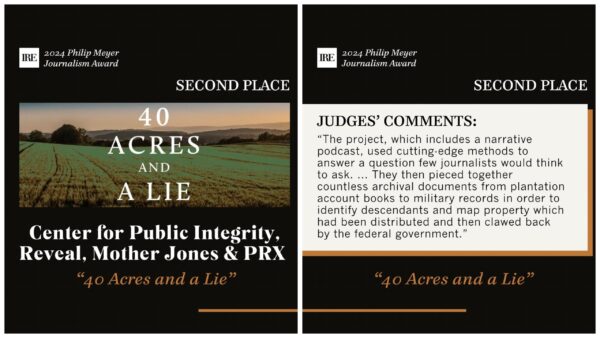
“There’s not a better conference focusing on data journalism,” said Associate Dean Jeremy Sanchez Rue (‘07) , who leads the school’s multimedia track and attended the conference this year. “Not only do our students benefit, but it gives us an opportunity to host gatherings with our alumni working at top news outlets around the country.”
In recognition of the importance of the conference to the field, Berkeley Journalism has regularly funded students to attend.
At NICAR, Berkeley Journalism faculty and alums are often called to speak on panels. This year, one of our current students was as well.
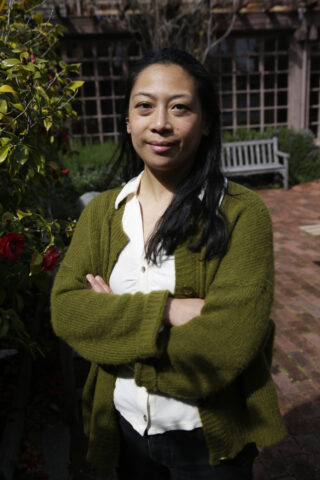
Elizabeth Santos (‘25)
Elizabeth Santos (‘25), a data journalist at the Investigative Reporting Program, served on a panel “Turning police disciplinary files into data and stories,” which highlighted her contributions to KQED’s investigative podcast “On Our Watch” and the California Reporting Project. Panelists discussed what it’s like to get your hands on a trove of documents and the life of a document dump: from a mess of PDFs to high-impact reporting that relies on everything from hand-annotating to artificial intelligence to find stories in the haystacks of text.
“As a journalist specializing in data, I’m incredibly grateful that I got to talk about the work we do at the California Reporting Project,” Santos said. “Every day we use evolving AI tools and apply them to public interest reporting. It was an honor to be included amongst so many journalists, many of them women, who work at the forefront of technology and journalism.”

KQED’s investigative podcast “On Our Watch” — reported by alum Sukey Lewis’ (’15) — takes listeners inside California State Prison, Sacramento, known as New Folsom. The podcast tells the story of two correctional officers who work in an elite investigative unit and what happens when they report corruption and abuse by their fellow officers.
LaFleur served on three panels, one on mastering the power of mapping with QGIS to find patterns in data that can only be explored on a map. Her session explored the open-source tool QGIS, how to build thematic maps and how to find geographic relationships in data. She and Reuters’ Jaimi Dowdell did a session about reporting on numbers, and she moderated a panel about tools for finding new revelations in previously inaccessible historical collections, which included the “40 Acres and a Lie” team.
“40 Acres and a Lie” takes a deep dive into a program that gave land to some formerly enslaved people after the Civil War, only to take nearly all of it back. This team of journalists identified more than 1,250 formerly enslaved people who received land — and their descendants. The project included a tool that powered the investigation by surfacing documents from the Freedmen’s Bureau.
The series also recently won a prestigious duPont-Columbia Award and won the SPJ NorCal award for Public Service.
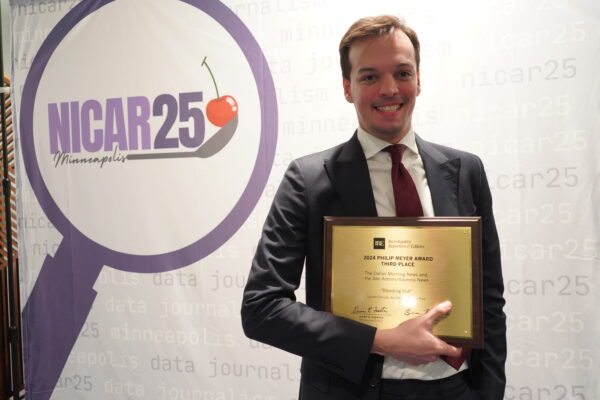
Ari Sen holding his third place award at NICAR25 conference in Minneapolis. Photo courtesy of Investigative Reporters and Editors.
Sen’s award-winning story “Bleeding Out,” exposed how faster access to blood could have potentially prevented the thousands of annual trauma deaths across the country. The judges called it “a critical accounting of trauma death within the American medical system.”
“I learned about Phil Meyer on my very first day of data journalism class at UNC, so receiving this award is a huge honor for me,” said Sen. “Meyer’s idea of hypothesis-driven “precision” journalism is an approach I first adopted fully when working on my thesis at Berkeley and continues to serve me to this day.”
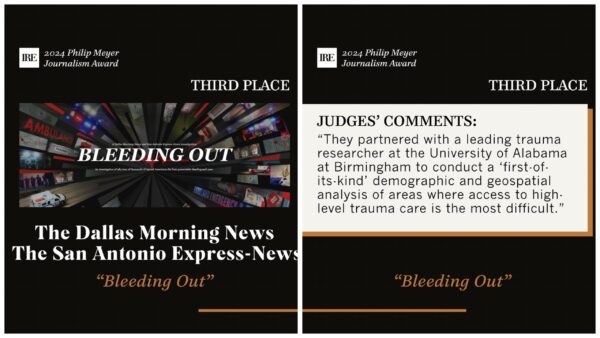
The series also won the Print/Online – Division II category of the 2023 Investigative Reporters and Editors (IRE) Awards, was a finalist for the Livingston Award in the national reporting category; won the National Association of Science Writers Science in Society Award in the series category and the Online Journalism Award for explanatory reporting in medium-sized newsrooms.
Two students awarded NICAR Fellowships
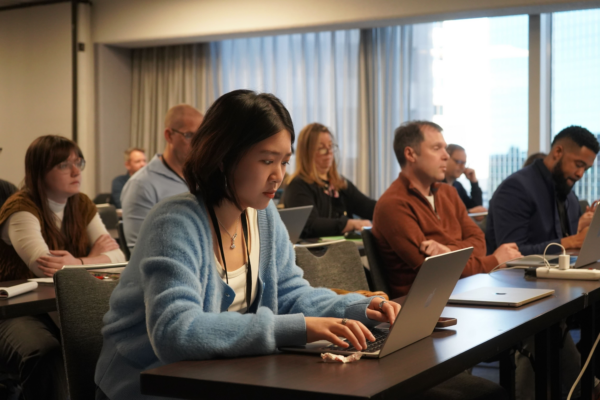
Ava Hu (‘26) at NICAR 2025. Photo courtesy of Investigative Reporters and Editors.
First-year students Ava Hu (‘26) and Daniella Jiménez (‘26) were awarded NICAR Fellowships to attend the conference. “Attending the conference reinforced my commitment to data journalism and showed me how impactful this work can be,” Hu said. “Learning from experienced journalists whose work I admire was both humbling and motivating.”
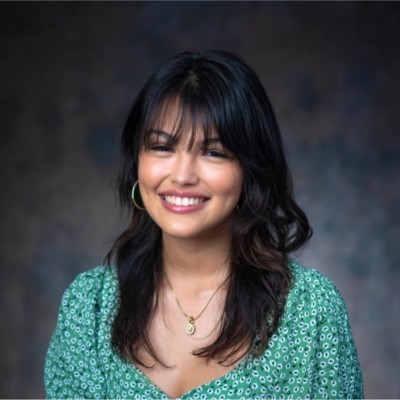
Daniella Jiménez
“Receiving this year’s fellowship not only allowed me to attend the conference and build incredible connections but also equipped me with new tools to bring back to the newsroom,” Jiménez said. “It reinforced how we can make our investigations more accessible and adaptable — not just for our readers, but for local newsrooms looking to recreate impactful reporting.”

Professor Jeremy Sanchez Rue hosts a Berkeley Journalism gathering at the conference attended by alums Ari Sen, Alex Matthews, Aaron Mendelson, Yolanda Martinez, Junyao Yang, Xueer Lu, Nazmul Ahasan, Mangyuan Dong and Sakura Cannestra and current students Ava Hu, Edison Wu, Iris Qiu, Ruchi Shahagadkar, Hailey Wang, Chelsea Long, Ziying “Tina” Chen, Andres Larios and visiting scholar Julia Mayer at our alumni reunion event.
Our prestigious multimedia program has been training graduate students in this evolving medium since the late 1990s. Donations to the program support student learning as well as student travel to industry conferences and award ceremonies celebrating their work. Support our multimedia and data journalists by donating to the Berkeley Journalism New Media Fund here.
